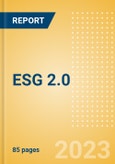Environmental, social, and governance or ESG is moving into a different era, which we call ESG 2.0. In this second phase, there will be a greater focus on the ‘E' component, with a shift from a voluntary regime to a mandatory one, driven by government mandates rather than consumer pressure. A host of new environmental laws are in the pipeline, relating to mandatory reporting, carbon pricing, and carbon import tariffs, as well as more state support and investment in clean energy technologies. Companies unprepared for ESG 2.0 face higher costs and lost sales.
The Inflation Reduction Act (IRA), President Biden's landmark climate policy, is the largest subsidy for clean energy and climate solutions in US history. It will direct $400 billion to develop US-based clean energy and electric vehicle manufacturing, as well as their supply chains. Anti-ESG states are among the biggest beneficiaries of IRA funding, which may make them more amenable to future climate policies.
Key Highlights
The EU will disrupt global industry by adding more sectors to its emissions trading system and phasing in the world's first carbon border tax. This is on top of a host of other ESG reporting and due diligence requirements that will apply to both EU and non-EU businesses.The Inflation Reduction Act (IRA), President Biden's landmark climate policy, is the largest subsidy for clean energy and climate solutions in US history. It will direct $400 billion to develop US-based clean energy and electric vehicle manufacturing, as well as their supply chains. Anti-ESG states are among the biggest beneficiaries of IRA funding, which may make them more amenable to future climate policies.
Scope
- It is no longer enough to have an ESG strategy focused on reporting and setting targets for some distant future date. Companies now need to show that they are taking action on ESG issues, especially emissions, across their value chain. This report outlines what companies can expect from ESG 2.0
- The report includes analysis of key trends shaping the ESG theme as the world moves from ESG 1.0 to the ESG 2.0 era. These trends are divided into three categories: corporate trends, macroeconomic trends, and regulatory trends
- It also includes an overview of global ESG-related policy initiatives, including the main policy plans and packages from the EU, the US, and China
- Also included is analysis of the publisher's signals data, including mergers and acquisitions, venture financing, sustainable bonds, hiring, and social media
- The report incorprates the publisher's ESG framework, designed to help companies build trust with society and set them on a path towards a sustainable future
Reasons to Buy
ESG 2.0 will be less forgiving of poor ESG performers, especially on environmental issues. Under ESG 2.0:
- Companies that fall behind on decarbonization will pay higher costs and lose sales
- Companies will be held accountable for ESG performance across their value chain, not just their own operations
- ESG-related marketing and communications will attract greater scrutiny from regulators and the anti-ESG movement
- Companies that cannot produce robust ESG data, especially emissions data, will struggle to trade internationally, even if they are not covered by mandatory reporting requirements
- Companies that cannot provide low-carbon goods and services will miss growth opportunities
Table of Contents
- Executive Summary
- Thematic Briefing
- Timeline
- Trends
- Global Policy Overview
- ESG Reporting Standards
- Signals
- Glossary
- Appendix I: ESG Framework
- Appendix II: ESG Disclosure Metrics
- Further Reading
- Thematic Research Methodology








